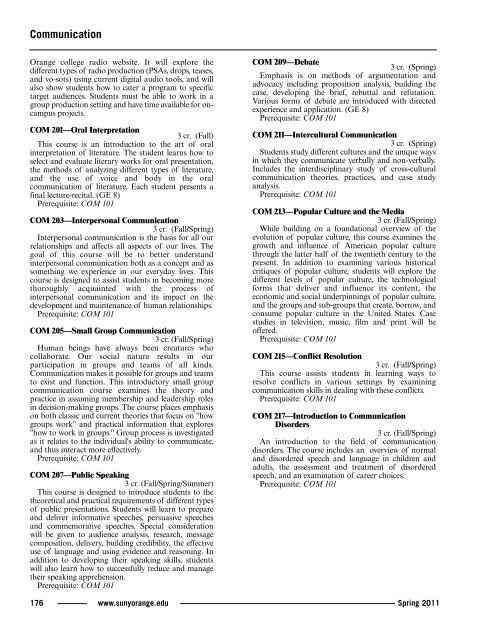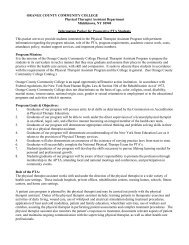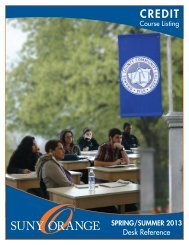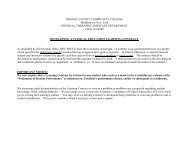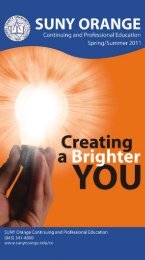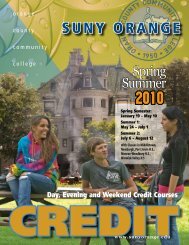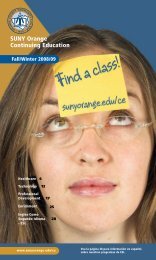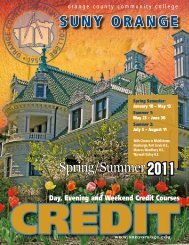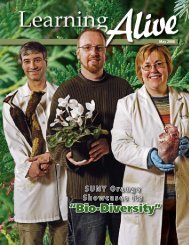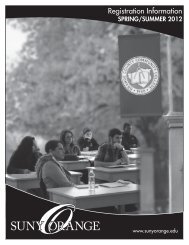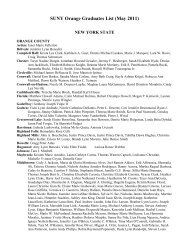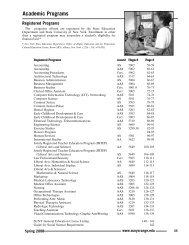Indexed Adobe PDF (Spring 2011-Full Version) - SUNY Orange
Indexed Adobe PDF (Spring 2011-Full Version) - SUNY Orange
Indexed Adobe PDF (Spring 2011-Full Version) - SUNY Orange
- No tags were found...
Create successful ePaper yourself
Turn your PDF publications into a flip-book with our unique Google optimized e-Paper software.
Communication<strong>Orange</strong> college radio website. It will explore thedifferent types of radio production (PSAs, drops, teases,and vo-sots) using current digital audio tools, and willalso show students how to cater a program to specifictarget audiences. Students must be able to work in agroup production setting and have time available for oncampusprojects.COM 201—Oral Interpretation3 cr. (Fall)This course is an introduction to the art of oralinterpretation of literature. The student learns how toselect and evaluate literary works for oral presentation,the methods of analyzing different types of literature,and the use of voice and body in the oralcommunication of literature. Each student presents afinal lecture-recital. (GE 8)Prerequisite: COM 101COM 203—Interpersonal Communication3 cr. (Fall/<strong>Spring</strong>)Interpersonal communication is the basis for all ourrelationships and affects all aspects of our lives. Thegoal of this course will be to better understandinterpersonal communication both as a concept and assomething we experience in our everyday lives. Thiscourse is designed to assist students in becoming morethoroughly acquainted with the process ofinterpersonal communication and its impact on thedevelopment and maintenance of human relationships.Prerequisite: COM 101COM 205—Small Group Communication3 cr. (Fall/<strong>Spring</strong>)Human beings have always been creatures whocollaborate. Our social nature results in ourparticipation in groups and teams of all kinds.Communication makes it possible for groups and teamsto exist and function. This introductory small groupcommunication course examines the theory andpractice in assuming membership and leadership rolesin decision-making groups. The course places emphasison both classic and current theories that focus on "howgroups work" and practical information that explores"how to work in groups." Group process is investigatedas it relates to the individual's ability to communicate,and thus interact more effectively.Prerequisite: COM 101COM 207—Public Speaking3 cr. (Fall/<strong>Spring</strong>/Summer)This course is designed to introduce students to thetheoretical and practical requirements of different typesof public presentations. Students will learn to prepareand deliver informative speeches, persuasive speechesand commemorative speeches. Special considerationwill be given to audience analysis, research, messagecomposition, delivery, building credibility, the effectiveuse of language and using evidence and reasoning. Inaddition to developing their speaking skills, studentswill also learn how to successfully reduce and managetheir speaking apprehension.Prerequisite: COM 101COM 209—Debate3 cr. (<strong>Spring</strong>)Emphasis is on methods of argumentation andadvocacy including proposition analysis, building thecase, developing the brief, rebuttal and refutation.Various forms of debate are introduced with directedexperience and application. (GE 8)Prerequisite: COM 101COM 211—Intercultural Communication3 cr. (<strong>Spring</strong>)Students study different cultures and the unique waysin which they communicate verbally and non-verbally.Includes the interdisciplinary study of cross-culturalcommunication theories, practices, and case studyanalysis.Prerequisite: COM 101COM 213—Popular Culture and the Media3 cr. (Fall/<strong>Spring</strong>)While building on a foundational overview of theevolution of popular culture, this course examines thegrowth and influence of American popular culturethrough the latter half of the twentieth century to thepresent. In addition to examining various historicalcritiques of popular culture, students will explore thedifferent levels of popular culture, the technologicalforms that deliver and influence its content, theeconomic and social underpinnings of popular culture,and the groups and sub-groups that create, borrow, andconsume popular culture in the United States. Casestudies in television, music, film and print will beoffered.Prerequisite: COM 101COM 215—Conflict Resolution3 cr. (Fall/<strong>Spring</strong>)This course assists students in learning ways toresolve conflicts in various settings by examiningcommunication skills in dealing with these conflicts.Prerequisite: COM 101COM 217—Introduction to CommunicationDisorders3 cr. (Fall/<strong>Spring</strong>)An introduction to the field of communicationdisorders. The course includes an overview of normaland disordered speech and language in children andadults, the assessment and treatment of disorderedspeech, and an examination of career choices.Prerequisite: COM 101176 www.sunyorange.edu <strong>Spring</strong> <strong>2011</strong>


